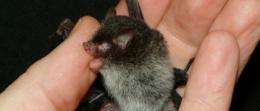Three new bat species discovered in Indochina

Three new bat species have been discovered after an international team of scientists from the Hungarian Natural History Museum (HNHM) and Fauna & Flora International (FFI) embarked on a study in southern Indochina.
Nocturnal and secretive, bats are often overlooked components of tropical diversity. The study, commissioned to address this lack of knowledge, has turned up three new bat species. Among these is the aptly named Beelzebub’s tube-nosed bat, a diminutive but demonic-looking creature known only from Vietnam.
The etymology of the species is explained in the Journal of Mammalogy, in which the citation appears: “Beelzebub commonly appears as a high ranking personality of the underworld in Christian texts, in both Old and New testaments, although one of the presumed original meanings of the name is ‘Lord of the Flies’.” Dr. Gabor Csorba of the HNHM further clarifies, “We chose the name Beelzebub to reflect the dark ‘diabolic’ colouration of the new species and its fierce protective behaviour in the field.”
“As with Beelzebub’s, the other two new species belong to a distinctive group known as tube-nosed bats”, said Dr. Neil Furey of FFI. “These species are highly adapted to forest environments, a fact which renders them especially vulnerable to ongoing deforestation in the region.” Surrounded by myth and facing a litany of threats, scientists are currently racing to document the poorly known bat fauna of the region. “Though bats already represent nearly a third of SE Asian mammals, recent genetic research suggests that the true number of species in the region may be twice that presently known,” noted Professor Paul Racey, FFI Vice Chairman and IUCN Bat Specialist Group representative.
“Discovering these new species, while exciting, really represents just the beginning,” added Dr Furey. “We know very little about the ecology of the group and the effects of forest degradation in particular, though some species are relatively common in secondary forest and roost in banana, a classic feature of such forests.”
More information: Csorba, G., et al. 2011. Revealing cryptic bat diversity: three new Murina and redescription of M. tubinaris from Southeast Asia. Journal of Mammalogy 92(4):891-904.
Provided by Fauna & Flora International


















